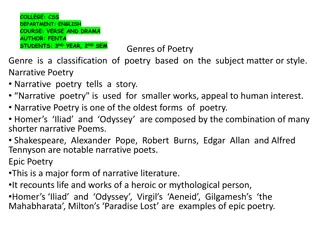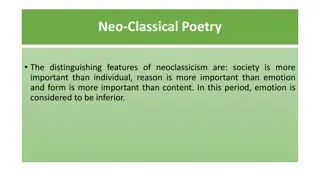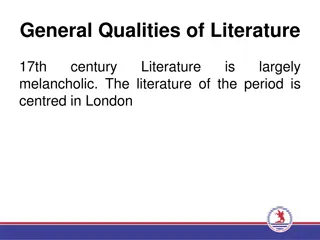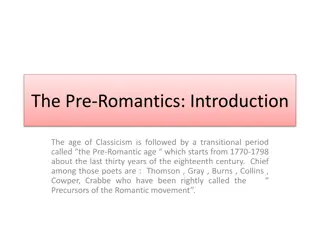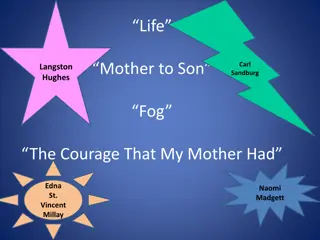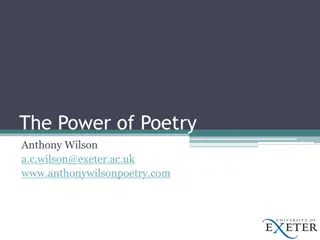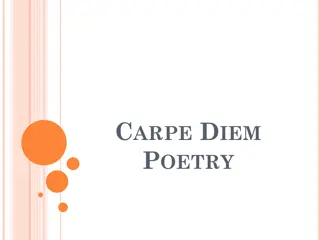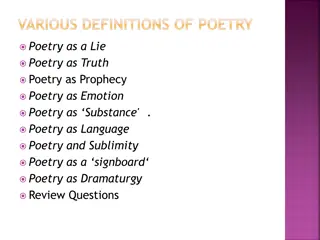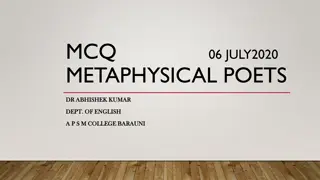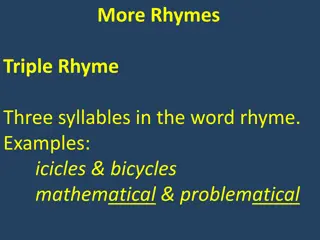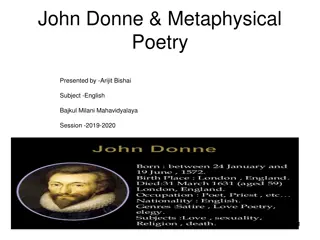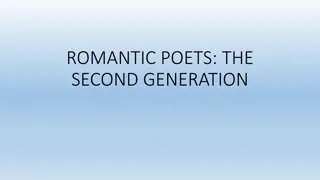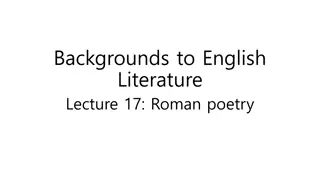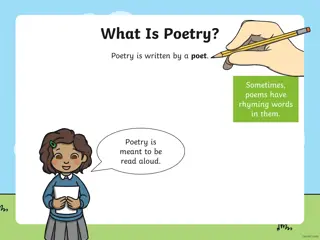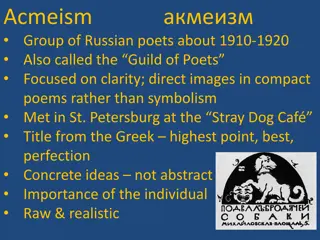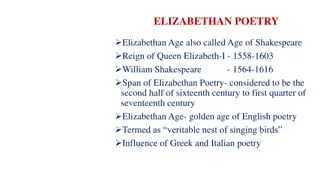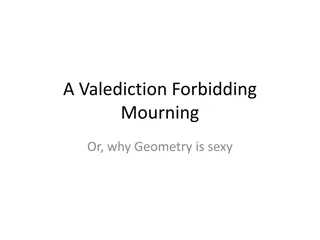Exploring Metaphysical Poetry: Origins, Elements & Poets
Discover the essence of Metaphysical poetry, rooted in 17th-century England and characterized by ingenious wit, philosophical depth, and intricate literary devices. Learn about prominent poets like John Donne and George Herbert, explore themes of love and spirituality, and unravel the challenging yet rewarding nature of this genre marked by metaphysical conceits and concise verses.
Download Presentation

Please find below an Image/Link to download the presentation.
The content on the website is provided AS IS for your information and personal use only. It may not be sold, licensed, or shared on other websites without obtaining consent from the author. Download presentation by click this link. If you encounter any issues during the download, it is possible that the publisher has removed the file from their server.
E N D
Presentation Transcript
PRINCIPLES OF LITERARY CRITICISM I MA
Metaphysical Poetry - Definition Metaphysical poetry, a term coined by Samuel Johnson, has its roots in 17th-century England. This type of poetry is witty, ingenious, and highly philosophical. Its topic includes love, life and existence. It uses literary elements of similes, metaphors, imagery, paradoxes, conceit, and far-fetched views of reality.
Metaphysical Poets The most important metaphysical poets are John Donne, George Herbert, Henry Vaughan, Abraham Cowley, Richard Crashaw, and Andrew Marvell.
Characteristic Features of Metaphysical Poetry Themes: Metaphysical poetry is spiritual & has often religious themes. Moreover, it focuses on love, as the union of soul. Literary Devices: Metaphysical poetry uses metaphors, puns, paradoxes & meter to create speculation. In addition, Metaphysical poetry uses scientific, medical & legal words & phrases to create arguments about the philosophical aspect of life.
Poets: Metaphysical poets were men of high intellect. They were all graduated from Oxford University, Cambridge University or they studied at one of the Inns of Court in the city of London. With the help of their vast knowledge, they presented new ideas & stories to their readers. Unclarity: Metaphysical poetry is considered highly ambiguous & obscure due to high intellect & knowledge of metaphysical poets. The poetry is greatly challenging to understand at the first reading. It needs full concentration & full attention to getting to the roots of the matter.
Short Poems: Metaphysical poetry is considered to be brief & concise. Every line conveys a lot of meanings in a few words. Every word is adjusted in every line like a brick in a wall & conveys the message of the author. Hence there is no wastage of words. Sayings in the Poetry: Metaphysical poetry is a vast collection of maxims & sayings. Thus epigrammatic quality is part & parcel of the metaphysical poetry. John Donne is a pioneer in this regard.
Metaphysical Conceits:A significant feature of the metaphysical poetry is the use of metaphysical conceits. It is the unique quality of metaphysical poetry. A conceit is a comparison of two dissimilar things, which may have very little in common.
Originality: Originality is the hallmark of metaphysical poets. All the metaphysical poets were unique & original in their ideas & thoughts. They didn t follow the path of their contemporary poets. They stood against their contemporaries & followed their own way of writing poetry. Wit: Metaphysical wit is also a noteworthy feature of metaphysical poetry. Metaphysical wit is the expression of one s idea & thoughts, using aptly & technically, the words & various figures of speech in such a manner as to provide pleasure to the readers. John Donne is called the Monarch of Wit in the history of metaphysical poetry.
Platonic Love: Platonic love is another feature of metaphysical poetry. Platonic love means, spiritual love, which is free from elements of physical love. Conclusion Metaphysical poetry is not intended to be read in a passive way. Its use of paradox, imagery, conceit & wit is meant to awaken the reader. Metaphysical poetry asks the philosophical questions about religion, faith, spirituality & being.
METAPHOR Ametaphor is a figure of speech that is used to make a comparison between two things that aren't alike but do have something in common. Unlike a simile, where two things are compared directly using like or as, a metaphor's comparison is more indirect. A metaphor is very expressive; it is not meant to be taken literally. You may have to work a little to find the meaning in a metaphor. For ex: Her tears were a river flowing down her cheeks. As a river is so much larger than a few tears, the metaphor is a creative way of saying that the person is crying a lot.
The classroom was a zoo. The snow is a white blanket. The world is a stage.
CONCEIT A conceit is a type of metaphor, a comparison of two unlike things for the purpose of creating an extended meaning. In literature, there are two main types of conceit, the metaphysical and the Petrarchan. Petrarchan conceits, named after the medieval Italian poet Petrarch, are exaggerated comparisons between the beloved and the natural world. "Her eyes are heavenly stars" is a Petrarchan conceit. Metaphysical conceits, made popular by the seventeenth-century poets. John Donne, used comparisons between unlike things designed to bring forth the metaphorical meaning of the poem. At the beginning of "The Sun Rising," Donne calls the sun a "busy old fool" for ending his night with his lover, which begins an extended discussion of the relationship between love and time.
Wit is a form of intelligent humour, the ability to say or write things that are clever and usually funny. A wit is a person skilled at making clever and funny remarks.
The Essay: Its Significance Eliot s essay on The Metaphysical Poets was first published as a review of J.C. Grierson s edition of Metaphysical Lyrics and Poems of the 17th Century. But the essay is much more than a mere review. It is a critical document of much value and significance. It is an important landmark in the history of English literary criticism, it has brought about a revaluation and reassessment of Donne and other Metaphysical poets, and has caused a revival of interest in these poets who had been neglected for a considerable time. It is in this essay that Eliot has used, for the first time, the phrases Dissociation of Sensibility and Unification of Sensibility, phrases which have acquired worldwide attention and had a far reaching impact on literary criticism.
Eliots Purpose Eliot begins the essay by praising Grierson s scholarly edition of metaphysical lyrics and poems of the 17th century. This is an admirable piece of criticism in itself, as well as a provocation to criticism. Eliot proposes to consider the significance of the label Metaphysical which has generally been used as a term of abuse to indicate the quaint tastes of these poets, and also to examine whether the so-called metaphysical poets constituted a school or movement in themselves, or were they merely a continuation of some older tradition.
Difficulties in the Way Eliot is quite conscious of the difficulties of the task he has undertaken. First, it is difficult to define the term, metaphysical and explain the characteristics which differentiate metaphysical poetry from other kinds of poetry. Secondly, it is difficult to decide which poets practised it and which did not, and which of their verses have such characteristics etc. In the beginning of the 17th century, there are noticeable three different schools of poetry:
First, John Donne, and his metaphysical kind of poetry. Marvell and Bishop King who are very close to him. Secondly, Ben Jonson and his courtly school of poetry, a kind of poetry which expired in the next century . Thirdly, the religious poetry of Herbert, Vaughan and Crashaw. It is difficult to find characteristics which are common to all these poets, and which are dominant enough to mark out these poets as a distinct group.
Eliot then proceeds to examine one by one with suitable illustrations the characteristics which are generally considered metaphysical . First, there is the elaboration of a simile to the farthest possible extent to be met with frequently in the poetry of Donne and Cowley. The most striking instance of such elaboration is the famous conceit of a pair of compasses in Donne s A Valediction: Forbidding Mourning. Secondly, there is the device of the development of an image by rapid association of thought requiring considerable agility on the part of the reader.
For example, in Donnes A Valediction: of Weeping, we have three separate images: the picture of the geographer s globe, the tears of the poet s beloved, and the picture of the Great Flood. Though these three pictures are entirely separate, the poet has unified them by stressing the likeness between his lady s tears and the globe, and further that they are capable of overflowing the earth. Thirdly, on other occasions Donne produces his effects by sudden contrasts. Thus in the line, A bracelet of bright hair about the bone , the most powerful effect is produced by sudden contrast of the associations of bright hair and bone . But such telescoping of images and contrast of associations are not a characteristic of the poetry of Donne alone
It also characterises Elizabethan dramatists like Shakespeare, Webster, Tourneur and Middleton. This suggests that Donne, Cowley and others belong to the Elizabethan tradition and not to any new school. The dominant characteristics of Donne s poetry are also the characteristics of the great Elizabethans.
Dr. Johnsons Definition Eliot then takes up Dr. Johnson s definition of metaphysical poetry, in which he tried to define this poetry by its faults. He said that, in Metaphysical poetry the most heterogeneous ideas are yoked by violence together . They bring together of heterogeneous ideas and compel them into unity by the operation of the poet s mind. Countless instances of such fusion of opposite and dissimilar concepts can be cited at random from all poets. Such unity is present even in the poetry of Johnson himself.
Dr. Johnsons remark lies in the fact that in his view, the Metaphysical poetry could only Yoke by violence dissimilar ideas. They could unite them or fuse them into a single whole. But this is not a fact. A number of poets of this school have eminently succeeded in uniting heterogeneous ideas. Eliot quotes from Herbert Cowley, Bishop King and other poets in support of his contention. Therefore, he concludes that Metaphysical poetry cannot be differentiated from other poetry by Dr. Johnson s definition. The fault which the learned doctor points out is not there, and the unity of heterogeneous ideas is common to all poetry.
DEFINITION OF JOHNSON The most heterogeneous ideas are yoked by violence together; nature and art are ransacked for illustrations, comparisons, and allusions; their learning instructs, and their subtilty surprises; but the reader commonly thinks his improvement dearly bought, and, though he sometimes admires, is seldom pleased." Dr.Johnson (The Lives of Poets or Life of Cowley)
The Special Virtue of the Metaphysicals A shrewd and sensitive critic like Dr. Johnson failed to define and point out the faults of M P. Eliot, therefore, purposes to use the opposite method, the positive approach, and point out the characteristic virtue of this school of poetry. Dr. Johnson has rightly pointed out that these poets were analytic ; they were given too much analysis and direction of particular emotional situations. But he has failed to see that they could also unite into new wholes the concepts they had analysed. Eliot would show that their special virtue was the fusion of heterogeneous material into a new unity after its dissociation. In other words, he would show that metaphysical poetry is distinguished from other poetry by unification of sensibility, and that subsequently, dissociation of sensibility.
Unification of Sensibility By unification sensibility, T. S. Eliot means a fusion of thought and feeling , a recreation of thought into feeling , a direct sensuous apprehension of thought . Such fusion of thought and feeling is essential for good poetry.
The great Elizabethans and early Jacobians had developed unified sensibility which is expressed in their poetry. By sensibility he means a synthetic faculty which can amalgamate and unite thought and feeling, which can fuse into a single whole the varied and disparate, often opposite and contradictory experiences. The Elizabethans had such a sensibility. They were widely read, they thought on what they read, and their thinking and learning modified their mode of feeling. Thus in the poetry of Chapman and others there is, a sensuous apprehension of thought a unification of thought and feeling and a recreation of thought into feeling. Their reading and thinking alters theirs feeling, this modified feeling is expressed in their poetry, and hence they had their unification or synthesis of thought and feeling. Eliot gives concrete illustrations to show that such unification of sensibility, such fusion of thought and feeling, is to be found in the poetry of Donne as well as in much of modern poetry, but it is lacking in the poetry of Tennyson
Dissociation of Sensibility The fact is that after Donne and Herbert a change came over the mind of England. The poets lost the capacity of uniting thought and feeling. The unification of sensibility was lost, and dissociation of sensibility set in. After that the poets can either think or they can feel; there are either intellectual poets who can only think, or there are poets, who can only feel. The poets of the 18th century were intellectuals, they thought but did not feel; the romantics of the 19th century felt but did not think. Tennyson and Browning can merely reflect or ruminate
He writes: Tennyson and Browning are poets and they think; but they do not fell their thought as immediately as the odour of a rose. A thought to Donne was an experience; it modified his sensibility. When a poet s mind is perfectly equipped for its work, it is constantly amalgamating disparate experience; the ordinary man s experience is chaotic, irregular, fragmentary. The latter falls in love, or reads Spinoza and these two experiences have nothing to do with each other, or with the noise of the typewriter or the smell of cooking, in the mind of the poet these experiences are always forming new wholes.
Metaphysical Sensibility the metaphysical poets had a mechanism of sensibility a unified sensibility which enabled them to assimilate and fuse into new wholes most disparate and heterogeneous experiences. They could feel their thoughts as intensely as the odour of a rose, that is to say they could express their thoughts through sensuous imagery. In his poems, Donne express his thoughts and ideas by embodying them in sensuous imagery and it is mainly through the imagery that the unification of sensibility finds its appropriate expression. The operation of the unified sensibility in Donne may be illustrated by the following lines from Dante s Paradise: (P.184)
EXAMPLE Within its depths I saw in gathered, bound by love in one mass, the scattered leaves of the universe: substance and accidents and their relations, as though together fused, so that what I speak of is in one simple flame. In the above lines the spiritual experience, which is so very different from the ordinary experience, has been expressed by Dante concretely by a masterly use of the imagery of light. Dante has given expression to his spiritual experience in sensuous terms, in a visual image, the simple flame. This is also frequently the method of Donne.
Milton and Dryden: Their Influence Like Elizabethan dramatists, the Metaphysicals, too, could be simple, artificial, difficult or fantastic. Both Milton and Dryden were great poets and they rendered important service to the cause, of poetry. Under their influence, the English language became more pure and refined. But at the same time, the feeling became more crude. It is for this reason that the feeling expressed in Gray s Country Churchyard is cruder and less satisfying than the feeling expressed in Marvell s Coy Mistress
Tennyson and Browning, could only reflect. They mediated upon their experiences poetically, but failed to turn them into poetry. The Metaphysical poets certainly had their faults. But they had one great virtue. They tried, and often succeeded in expressing their states of mind and feeling in appropriate words and imagery. They had unified sensibility and they could find verbal equivalents for it. They were, therefore, more mature and better than later poets.
CONCLUSION Donne and the other Metaphysicals are in the direct current of English poetry, and the modern poets are their direct descendants. This current flows direct from the Elizabethan age right upto the modern age. Only, and unfortunately, this continuity was broken for some time under the influence of Milton and Dryden who are great masters of language, but not of the soul. The poet must look not only into their hearts and write, but also they must look into the cerebral cortex, the nervous system and the digestive tracts. The poet has different faculties and sensibilities, must achieve a unification of his sensibilities, and must express this unified sensibility into his poetry. Only such a poetry would be complete; but it would be complex and difficult. The Metaphysicals, as well as the moderns, have this complexity, and also this completeness and maturity.
References A Comparative Study of Ved Vyasa s Garuda Purana and Dante Alighieri s Inferno in The Divine Comedy To His Coy Mistress Valediction: Weeping Dance of Shiva ---- Ananda Coomarasamy
15th century short poem written by poet kavi Kalamegam In this poem, you will see philosophy, religion, devotion and mathematics - - The song as such means this: Before you start using a third leg ( , a walking stick), before your hair turns grey ( ), before you sight the minions ( - minions of Yama or the legs of Yama) of Yama ( , who have come to take your life), before you fall sick, hick-up ( ) and cough ( ) before you are taken to the great land (grave yard, ), (that is, before you age and die) go today and hail the lord who dwells under the shade of a single mango tree ( ) in Kanchi ( ) ("Hail Ekaambarar, in Kanchi, before your time runs out" is the gist of this song!)
METAPHYSICAL (TAMIL) Tolkaappiyam The Tirumantiram of Tirumular The Ninth and the final Tantra deals with some metaphysical issues related to mantras. But the most significant theme is that of the Dance of Siva and how it is related to not only the mantras but also deeper metaphysical darsanas.


